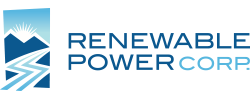Run of the River Technology
Run of River hydroelectricity is the most efficient and environmentally friendly way to produce electricity. These smaller scale hydro plants (sometimes referred to as "microhydro") produce no emissions and are not as dependent on unpredictable weather patterns as solar and wind power are.
Energy is generated by harnessing the forces of water flow and gravity from a river or creek that has a natural drop. At the highest point of a run of river facility, a weir (or, small dam) creates a holding pond which slows the flow of water without creating the flooding required by larger hydroelectric plants. A Coanda screen filters out debris and keeps fish safely out of the system.
Water then enters an intake which allows a portion of water into a large pipeline, called a penstock. The water moves downward with gravity through the penstock to a power station at the bottom, gaining pressure as it falls.
When the water hits the power station, its high pressure flow is channeled into spear nozzles which spray high velocity streams at turbines with curved blades which in turn spin. The turbines are connected to a generator, which transforms mechanical energy into electrical energy by spinning coils of wire near a magnetic iron core. This creates alternating current (AC) as it changes the magnetic field of the core by cycling past its positive and negative poles. Sophisticated electronic equipment precisely regulates the flow of electricity before sending the energy to the outside power grid.






